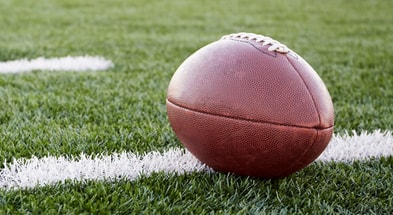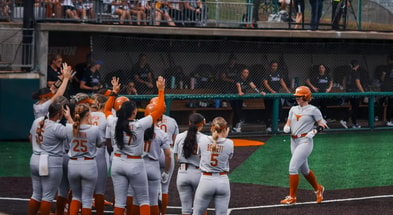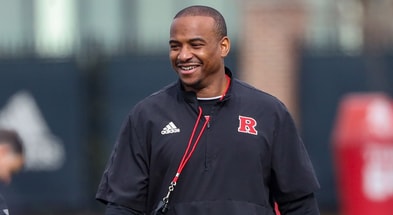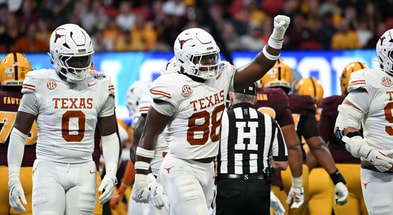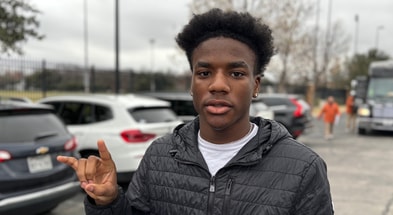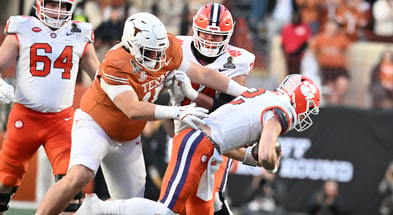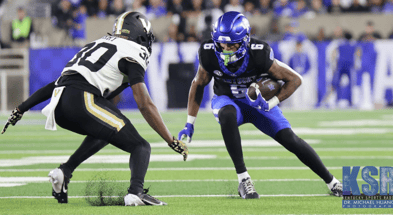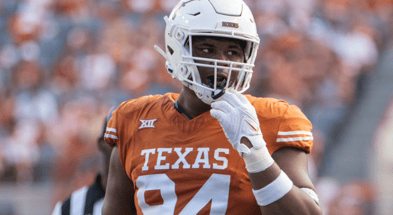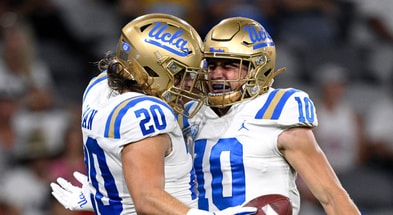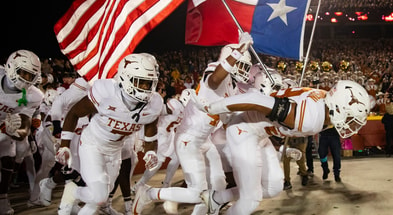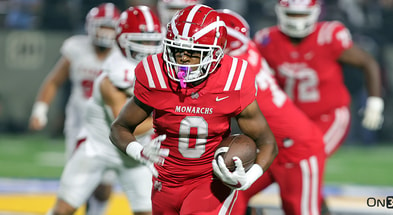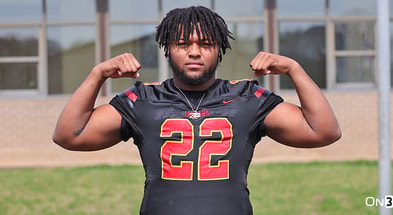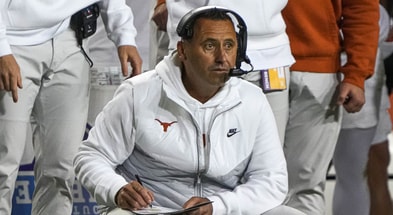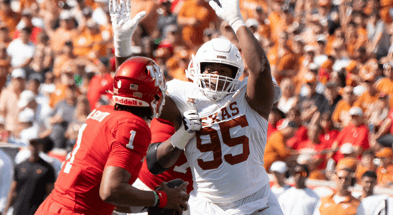Inside the Gameplan: Rebuilding DBU in 2017

The reason the Big 12 successfully produces multiple 1k yard WRs and highly successful QBs every year becomes evident when you take the time to watch every player in a given year joining a Big 12 program, as I’ve done. The state of Texas in particular produces a multitude of talented skill athletes at the WR position.
What’s more, while Briles and the members of his coaching tree are now gone from the Big 12 conference, his influence remains in the combination of vertical routes from three-receiver sets with two-back run plays via play-action or RPO (run/pass options). This league is brutal on DBs and regularly puts CBs on islands against the likes of James Washington or Dede Westbrook and gets safeties and linebackers matched up guys like Jalen McCleskey or Daikiel Shorts while they are trying to sort out run responsibilities.
The key area where a Big 12 team can gain an advantage over the rest of the league is in fielding a top secondary that can counter and even diminish these passing attacks. This is where the school labelled #DBU should stand out but that hasn’t exactly happened over the last two seasons in Austin.
Here’s what Texas’ secondary has produced this decade in terms of team statistics:
The sad truth is that some of Texas’ more positive looking numbers this decade have been due primarily to an inability to stop the run. Teams have frequently determined to just run the ball rather than risking a throw because it wasn’t necessary. But while Texas has never managed to rebuild the brilliant 2009 secondary, the remnants of which departed after 2010, Texas has still seen a few great defensive backs and one legitimately standout unit in 2014.
With nearly everyone from 2016 returning (save for oft-harangued former walkon and recent Ehlinger victim Dylan Haines) the hope is that Todd Orlando and the new defensive staff can get Strong’s highly-touted DB recruits playing at a level that will make the Longhorns stand out in a league where DBs usually only get negative attention.
Positions in the Orlando secondary
As I noted in a previous post, the Orlando defense is built primarily around quarters coverages. The advantages of playing two-deep coverages these days can be found in the versatility of these coverages to adjust to different strengths and weaknesses from either the offense or defensive personnel as well as in the post-snap flexibility that comes from having a safety on either hash to react to the play.
However that versatility generally comes from having CBs that can play on an island at times and the flexibility depends on having safeties that can react accurately and quickly to what happens after the snap. Here are the five DB roles that Orlando relied on at Houston over the last few years and what they call for from the players.
Cornerback
After studying multiple games from both 2015 and 2016 I haven’t found any formational consistency to how Orlando likes to line up his cornerbacks. In 2016 he tended to play Howard Wilson as the right cornerback and Jeremy Winchester as the left cornerback but sometimes played them based on field vs boundary. In 2015 he moved Brandon Wilson and William Jackson to right or left, field or boundary, and I’m not sure whether that was based on WR matchups or some other factor.
At any rate, my conclusion is that every cornerback on the roster needs to be as complete a player as possible, capable of defending vertical routes without help over the top as well as supporting the run as a force player on the edge.
Generally quarters coverage provides help for the cornerback on inside routes like the curl, post, or dig (though not necessarily) but it can also frequently leave him to handle the fade, hitch, out, or comeback by his lonesome. Cornerbacks need to be able to play WRs without getting beat deep down the sideline and ideally they can do so without conceding too much of a cushion.
Nickel
Orlando does play his outside linebackers as field and boundary (for the most part) and so the nickel is basically an outside linebacker who happens to be responsible for covering a ton of space. He needs to be able to play the edge against the run but to do so while covering some real distances.
As you can see from this screen shot, the boundary OLB (by the #30) has a lot less space to navigate in order to maintain the edge and handle the inside WR than does the field OLB (lined up on the far hash). So the nickel in a quarters defense is just an outside linebacker who needs to possess some speed.
However, Orlando also makes heavy use of fire zone blitzes in his defense, which ask the coverage players to play matchup zone/man defense on the various receivers. While these blitzes often involve the nickel as a blitzer, they more frequently ask him to cover the slot WR in man coverage, so this player needs to be pretty solid in coverage.
With all of those considerations in mind your nickel ends up needing to be a very versatile DB who’s effective against the run, smart enough to handle a lot of differing assignments (some of which require very quick reactions), and skilled enough to handle being isolated in coverage.
This range of assignments is not unique to the Orlando nickel and similar reasons have dictated why Texas has often played their most veteran and versatile DB (Aaron Williams, Kenny Vaccaro, Quandre Diggs, Duke Thomas) at that position.
Boundary safety
Because this safety is closer to the box and the action this is often a playmaking position in a quarters defense. The boundary safety has less range to cover on most snaps than the field safety so he needn’t necessarily be as fast and athletic but he’s more likely to have run fits in the box so he does need to be sturdier and plenty physical.
His proximity to the box means he can at times even blitz the edge but his most frequent tasks are playing over the boundary inside WR, serving as an extra run defender, playing as a deep half or deep middle zone defender, and playing as a “robber” on the inside. Obviously having a few years in the program to learn all that is invaluable.
Field safety
Tom Herman recently identified this guy as one of the two most important positions on defense because they have to set the call for the coverage based on the opponent’s formation. He might have added that they’re also responsible for adjusting to everything that happens after the snap and making sure everything goes alright while simultaneously navigating a lot of grass.
The field safety is going to spend most of his time either playing over the top and closing on the ball or else dropping down in man coverage to replace a blitzing nickel. Much like how it makes sense to put a physical corner in the nickel position, this safety position benefits from having a defender with real coverage savvy and the athleticism to make open field tackles. Ideally both the nickel and free safety would be plus coverage defenders but at least one of them really needs to be strong in this regard.
Top 10
- 1Breaking
Shedeur Sanders not drafted
Slide continues
- 2
10 Best Available Players
After Rounds 1-3 of NFL Draft
- 3
Picks by Conference
SEC, Big Ten continue to dominate Draft
- 4Hot
Jalen Milroe
Drafted before Shedeur Sanders
- 5Trending
Shedeur Sanders
Reportedly pranked by fake NFL team
Get the On3 Top 10 to your inbox every morning
By clicking "Subscribe to Newsletter", I agree to On3's Privacy Notice, Terms, and use of my personal information described therein.
Dime back
Orlando also likes to play some six DB sub-packages that remove the boundary outside linebacker and replace him with another DB that can play man coverage on a slot or blitz the edge. They used a safety in the role a year ago, which makes the most sense. The idea is just to upgrade the speed at the position and to get more coverage ability on the field so that, if facing four or five receivers on the field together, the defense can more credibly disguise where blitzes are coming from.
If you insist on leaving defenders out there that can’t cover any of the WRs on the field then the offense is going to more easily diagnose what you’re doing. So in such moments, Orlando would often roll with the dime package and move one of his better safeties into the dime role while playing a back-up at safety.
Altogether that’s five major roles and six positions that Texas’ secondary will need to fill. In addition to being able to gain an advantage over the rest of the Big 12 in fielding multiple good DBs in a league where good DBs are highly needed, it’s easy to see how having depth at every position can also set a team apart in the Big 12.
Filling the roles
Kris Boyd had a pretty solid 2016 with 48 tackles, five pass break-ups, two forced fumbles, and a game-sealing interception (two if you ask Justin Wells). He was perhaps at his best playing cover 2 and helping out against the run and for that reason would be the no. 1 contender at the boundary spot if Texas were to use a “field” and “boundary” corner. He’ll be likely to lock down one of the starting roles assuming he maintains the ferocity and focus that earned him a starting job last year.
The other spot will be determined by a major showdown between Holton Hill, Davante Davis, and John Bonney. For all of the flak he caught, Bonney ended up leading the team last year with nine pass break-ups and did a credible job of staying on top of routes last year and closing to make plays on the ball or tackles. Holton Hill is probably the most skilled CB on the team in terms of being left on an island outside but he’ll need to prove he’s worthy of trust. Davante Davis crumbled last year in the midst of the catastrophe that was the Texas defense but he’s generally been the most reliable of this whole bunch, combining some of Hill’s length and athleticism with Bonney’s assignment-sound play.
Because they are savvy with assignments and reliable tacklers, if Davante Davis or John Bonney lose out on the starting corner position it’s possible that they’ll be cross-trained or moved over to field safety where Texas will have great need of range and coverage ability. Last year they played DeShon Elliott in that space some and he was good when helping P.J. Locke to bracket slot receivers but inconsistent when trying to nail down the different assignments.
Brandon Jones is the best athlete to fill the field safety role because of his tremendous athleticism that could see him play most any position in the secondary. He’d also bring some value-add in his ability to drop down into the box from the far hash (assuming the nickel could survive without him. Elliott, Jones, Bonney, and Davis all have enough range to thrive here it’s simply a matter of who will own the duty of aligning the rest of the defense and living in the film room so as to keep the unit sound.
We mentioned earlier that nickel has a similar need for a versatile and veteran DB but young P.J. Locke seems to have this role sewn up thanks to his physical and heady play. Kris Boyd could fit really well here if the staff wanted to get him more involved and liked the coverage they could get from the other cornerbacks. Brandon Jones could also play here, like most everywhere else, but they should probably keep him at one spot until he nails it down so that they can ensure that he sees the field somewhere in 2017.
The boundary safety spot will probably be where Jason Hall makes his senior stand though his experience alone might get him in the mix at the field safety position. He was listed at 6-3, 216 last year and could thus be as likely to end up at LB as he was at field safety but it’s just hard to beat experience. The boundary spot should balance Hall’s safety experience and larger size but if not then Elliott, Jones, or young Chris Brown could prove to be intimidating presences those slots.
The dime spot will probably go to a safety or nickel based the best blitzers and where depth allows Orlando to pull players from. The last humidor depth chart for the secondary would then be best translated as follows:
CB: Davante Davis or Holton Hill
CB: Kris Boyd/John Bonney
Nickel: PJ Locke/Chris Brown
Boundary safety: Jason Hall/DeShon Elliott
Field safety: Brandon Jones/DeShon Elliott
Dime back: Jason Hall
The key storylines this spring will be how well Brandon Jones is learning the defense (thus determining whether he could man the free safety spot or whether someone like Hall or Bonney might have to slide over), who the best two cornerbacks are, and finally how the nickel position looks since it’s such a mentally and physically demanding job.
Once this staff figures out who their war horses are in this secondary they can work out which variations of quarters and what blitz combinations will set them up for success and start to piece together the remaining secondary roles together to ensure a coherent group. A couple of NFL caliber players combined with strong role players and DBU will stand out in the Big 12, I assure you.







